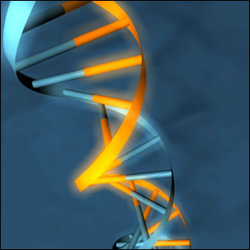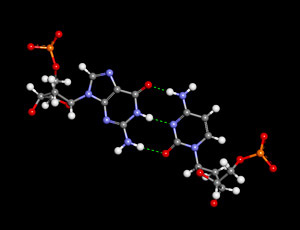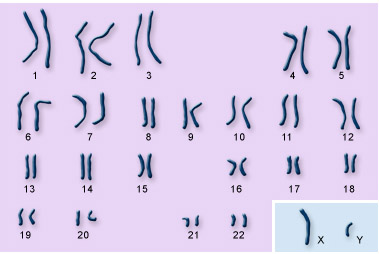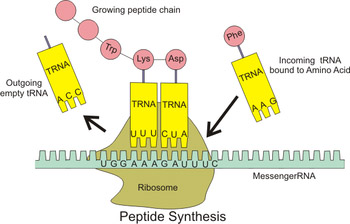What is the Human Genome? And How Big is It?
The hereditary material of all multi-cellular organisms is the famous double helix of deoxyribonucleic acid (DNA). This contains all of our genes. DNA, itself is made up of four chemical bases, pairs of which form the "rungs" of the twisted, ladder-shaped DNA molecules. These four molecules are adenine (A), thymine (T), cytosine (C), and guanine (G).
All genes are made up of stretches of these four bases (arranged in different ways and in different lengths).
You can view a 3-D rotatable image of DNA here...

Photo: National Institute of Health
A critical feature of DNA is the ability of the nucleotides to make specific pairs: . Adenine pairs with Thymine and Cytosine pairs with Guanine. We say A is complementary to T (and U) and C is complementary to G
The double helical structure of DNA, is due largely to hydrogen bonding between the base pairs (shown as green dotted lines in image to left), which link one complementary strand to the other
Hydrogen bonds between guanine and cytosine

The human genome of Homo sapiens is stored on 23 chromosome pairs. 22 of these are autosomal chromosome pairs, while the remaining pair is sex-determining. The haploid human genome occupies a total of just over 3 billion DNA base pairs that means 6 billion base pairs per diploid cell.
"The Human Genome Project (HGP) was one of the great feats of exploration in history - an inward voyage of discovery rather than an outward exploration of the planet or the cosmos; an international research effort to sequence and map all of the genes - together known as the genome - of members of our species, --Homo Sapiens"--genome.gov

Human Chromosomes
How many genes does the Human Genome contain?
The Human Genome Project has revealed that there are probably about 20,000-25,000 'haploid' protein coding genes. The completed human sequence can now identify their locations. But only about 1.5% of the genome codes for proteins, while the rest consists of non-coding RNA genes, regulatory sequences, introns, and noncoding DNA (once known as "junk DNA").
Surprisingly, the number of human genes seems to be less than a factor of two greater than that of many much simpler organisms, such as the roundworm and the fruit fly -- see table showing number of genes for different organisms.
How many genes do other organisms have?
| chromosomes --diploid | base pairs | genome size (#genes) | Reference | |
| fruit fly | 8 | 1.65x108 | 13,600 | |
| Budding yeast | 16 | 12,462,637 | 6,275 | |
| human | 46 | 3.3 x 109 | ~21,000 | |
| human mitochondria | 16,569 | 13 | ||
| rice | 24 | 4.66 x 108 | 46,022 -55,615 | |
| dog | 78 | 2.4 x 109 | ~25,000 | |
| mouse | 40 | 3.4 x 109 | ~23,000 |
Humans though have on average three times as many kinds of proteins as the fly or worm because of mRNA transcript "alternative splicing" and chemical modifications to the proteins. This process can yield different protein products from the same gene. --------Fruit flies share nearly 60% of human genes and are studied by
What do genes actually do?
Although genes get a lot of attention, it’s the proteins that perform most life functions and even make up the majority of cellular structures. Proteins are large, complex molecules made up of smaller subunits called amino acids. Chemical properties that distinguish the 20 different amino acids cause the protein chains to fold up into specific three-dimensional structures that define their particular functions in the cell.

Above: A ribosome is the component of a biological cell that creates proteins from all amino acids and RNA representing the protein.(Image: Wikipedia) Mitochondrial genome The human mitochondrial genome, while usually not included when referring to the "human genome", is of tremendous interest to geneticists, since it undoubtedly plays a role in mitochondrial disease. It also sheds light on human evolution; for example, analysis of variation in the human mitochondrial genome has led to the postulation of a recent common ancestor for all humans on the maternal line of descent. How different is the human genome from one person to the next? Scientists have identified about 1.4 million locations where single-base DNA differences (SNPs) occur in humans. This information promises to revolutionize the processes of finding chromosomal locations for disease-associated sequences and tracing human history. ref |
Further Readings
The Science Behind the Human Genome Project Basic Genetics, Genome Draft Sequence, and Post-Genome Science
What Genes in the Human Genome cause Celiac Disease? - Genetics of Celiac Disease and Gluten Sensitivity
Related Activies
- Mass Volume Density
- Molecular Modeling-- An NGSS Activity
- Water and Ice Module
- States of Matter
- How do molecules of solids, liquids and gas behave differently?
- Science of Fluids
- Buoyancy and Archimedes Principle
- Speed Velocity and Acceleration
- Gifted and Talented STEM
- EDinformatics Science Challenge
- How does a battery work?